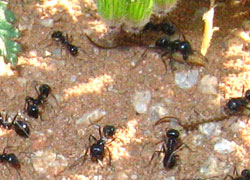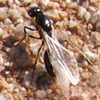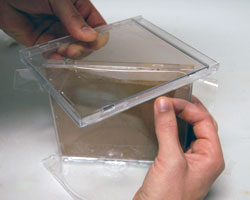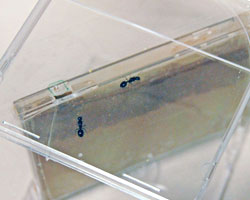
Illustrated by: Sabine Deviche
Collecting Ants
While it can be fun to watch ants outside, or perplexing to find them in your house, one of the most exciting ways to study ants is to keep them in an ant farm so you can see all of the action that goes on underground. But before you can keep them in an ant farm, you have to collect them first!
There are several different ways to get ants for an ant farm, depending on when you would like to start the farm and how long you would like for your ant farm to last.
I Want Ants Right Now!

If you want to start an ant farm fast and you want one that will only last for a few weeks or months, all that you will need are some worker ants, without a queen. The only trouble is, when there isn’t a queen around, worker ants don’t have much to do because they cannot lay any eggs. But sometimes that is the easiest and fastest option. If that’s what you would like to do, read about collecting worker ants here.
I Can Wait to Grow a Truly Spectacular Ant Farm

If you are very patient and are willing to wait until just the right time of year, you might be able to use your knowledge of the ant colony life cycle to collect ant queens and start a brand-new colony.
The Illuminated Underground: Building an Ant Farm
Say you’ve managed to get some ants, using one of the methods described in hunting for ants. Now what should you do with them?

Well, most of the excitement in an ant colony happens underground, which is usually hard for us to see because there’s a lot of dirt in the way. That’s what makes ant farms so great: they provide a very thin layer of dirt so the ants think they’re underground but you can still see what is going on. With a few basic tools, you can build your own ant farm out of two clear CD cases, add your ants, and enjoy watching the ants create their nest in the dirt.
Getting an Ant Colony Started: Long Live the Queen!
Once you have some ants introduced into your ant farm, they are pretty simple to take care of. All that they need are a source of food, some water, and a comfortable temperature.
The type of food that your ants require will depend on the kind of ant that you have collected. If you collected seed-harvester ants, you will need to give them some seeds to collect, such as grass seeds or birdseed.
In addition, it is very important to make sure that your ant farm has the right amount of moisture. If it’s too wet, the ants will drown, but if it’s too dry, the ants will be extremely thirsty. Usually it will take some time to figure out just how often you will need to water your ant farm, and how much water it will need. Try using an eyedropper or something small to add water a small amount at a time until the soil looks damp.

If you start an ant farm with just a queen, the next steps will be fascinating to watch. First, the queen will run around for a bit, and then she’ll hopefully decide to start to dig a new nest. After a few days of digging, she will probably stop digging and will start to lay eggs.
Eggs are usually incredibly small, about the size of a period at the end of a sentence, but eventually they will develop into new workers as they progress through the individual life cycle and become the start of the new colony!
Over time, the number of workers in the new colony will increase, meaning that your ant farm is successfully underway, and at this point, there are many different kinds of experiments that you can do with your ant farm! Be sure to make note of how the ants organize their nest, and how that changes as the colony grows.
Here are some helpful tips and tricks for keeping an ant farm.
Read more about: Collecting Ants
Bibliographic details:
- Article: Collecting Ants
- Author(s): Rebecca Clark
- Publisher: Arizona State University School of Life Sciences Ask A Biologist
- Site name: ASU - Ask A Biologist
- Date published: 25 Sep, 2009
- Date accessed: 17 May, 2025
- Link: https://askabiologist.asu.edu/explore/collecting-ants
APA Style
Rebecca Clark. (Fri, 09/25/2009 - 10:44). Collecting Ants. ASU - Ask A Biologist. Retrieved from https://askabiologist.asu.edu/explore/collecting-ants
Chicago Manual of Style
Rebecca Clark. "Collecting Ants". ASU - Ask A Biologist. 25 Sep 2009. https://askabiologist.asu.edu/explore/collecting-ants
MLA 2017 Style
Rebecca Clark. "Collecting Ants". ASU - Ask A Biologist. 25 Sep 2009. ASU - Ask A Biologist, Web. https://askabiologist.asu.edu/explore/collecting-ants
Be Part of
Ask A Biologist
By volunteering, or simply sending us feedback on the site. Scientists, teachers, writers, illustrators, and translators are all important to the program. If you are interested in helping with the website we have a Volunteers page to get the process started.






